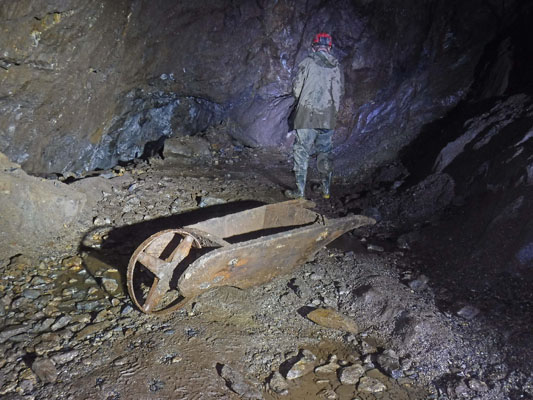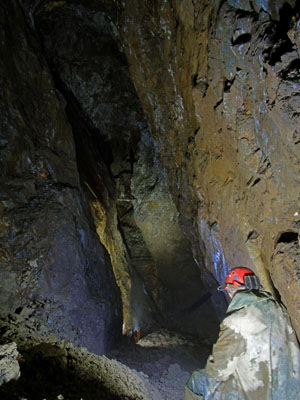| NAMHO 2019: Henfwlch |
| Last Updated: 10/05/2019 |
|
General I first entered the Henfwlch Adit which emerges at SN 737882, in the late 1980s. At that time it ended at a complete collapse just past Strides Shaft. O T Jones refers to it as “Hafan Shaft”. I was intrigued by a short heading on the left leading to a winze, this now know to be the no 1 winze. Talking to the late Damian McCurdy I was told that he had descended it with some friends and discovered a window into an enormous stope. In 1994, I returned to the mine, in order to descend the aforementioned winze. There was a length of timber across the level, put there as a belay for this purpose by Damian and his friends, I backed this up with a number of bolts. The winze was found to be about 50ft deep to a solid bottom where there were a number of sections of ladder which had fallen away from the sides of the shaft. There was a window to the west into the large stope, a floor of rubble being gained after a further few feet. Here, water coming down the winze disappeared into the floor. Progress inbye was prevented by a continuation of the collapse from the Adit above. Above a bank of deads, the stope was seen to extend about 15 metres in an outbye direction. This was done by the light of an Oldham lead acid caplamp, best lighting available at the time. I now see that I failed completely to appreciate the enormousness of the place, all I could see was a rising pile of rubble. This was the limit of my earlier explorations, however towards the end of the main level a gap in boulders draughted strongly, and in 1996 this was dug out into a passable winze. At a later date it was enlarged and reinforced with concrete. From here it was possible to climb back up to the level of the main adit at a point where it entered the inbye section of the main stope. here was an ore barrow in near perfect condition. The adit extends inbye with various exploratory levels and interesting features.
Up until recently the main stope was cut into two sections by the heavy fall in the main Strides Shaft. The outbye end only reached by a very wet abseil of about 50 feet down no 1 winze. I don't believe anyone has been there since my initial foray. Late in 2018 I commenced a dig through the fall to join the twp sections of the main stope. This was completed late December. I found myself looking down into a massive vertical stopes which plunged downwards immediately in front of me. My initial thoughts included “SRT”. The stope is vertical and looks from that high vantage point totally massive. Its actually about 75 metres long by about 3 or 4 metres wide and about 75 feet high from the bottom.
The descent will take delegates past the first waterfall coming down on the left. It has deposited a nice formation down the wall of the stope. Progressing down one reaches a point where the water disappears into the floor, this is the section that has dropped since my visit of about 25 years ago. At the back is a rock inscribed “RF 94”, Déjà vu. There is a nice view into the bottom of the no 1 winze with the remains of the collapsed ladders now liberally coated with flow deposit. This forms the second waterfall. The bank of deads and backfill extends about 15 metres, at the back a blind heading attempted to find a payable section of the lode, unsuccessfully. Only notable artefact is an old tea tin. The mine was worked down to a 30 fathom level, with levels at 10 and 20 fathoms. The top of the bank of dead work and backfill, a cross stemple and the base of the winze, all being on the same level causes me to think that this is the original horizon of the 10 fathom level. With partial collapse into the workings below.. Also the water disappearing into the floor must be exiting by the Hafan Deep Adit. Whether by natural fissure as the late David Bick suggests, or by a drift. We will never know. Of course a natural fissure could be a fraction of an inch or several feet forming in effect a natural cave. Also, "waterfall stope" is vertical, unlike "ore barrow" stope, which has a more pronounced dip on the lode. This whole mine is a very interesting place to explore with different kinds of rocks and colours. I fancy that it has been worked by tributers after it officially closed, as were other mines in the area. Random areas of backfill are everywhere with abundant signs of fosicking. Roy Fellows. 2018
Technicalities Knee deep wading. Some slight scrambling and hands and knees crawl through 2018 dig. Steep descent and climb back plus optional traverse in Waterfall Stope. Cows tails and belay belt required for this section.
Health and Safety Risk Assessment Trips Please refer to the trip list Meeting and Parking Very limited parking opposite the mine at SN 738883 by a culvert and just round a bend in the road. Main parking is at SN736885 adjacent to a track on the other side of the road. Nice views over the Nant y moch reservoir.
|

 Delegates
descending the stope will be using a fixed handline on the left which
enables a reasonably safe descent. The back of the stope is above a bank
of deadwork and is reached by an easy traverse. Cowstails will be
required, good belay belt sufficient. Thos part is optional. Care should
be taken here as there is a significant collapse into workings below, care
needed here, edge crumbling. This gives an indication as to the likely
true nature of it. Not a bank of deads and backfill but the top of a stull.
Delegates
descending the stope will be using a fixed handline on the left which
enables a reasonably safe descent. The back of the stope is above a bank
of deadwork and is reached by an easy traverse. Cowstails will be
required, good belay belt sufficient. Thos part is optional. Care should
be taken here as there is a significant collapse into workings below, care
needed here, edge crumbling. This gives an indication as to the likely
true nature of it. Not a bank of deads and backfill but the top of a stull.